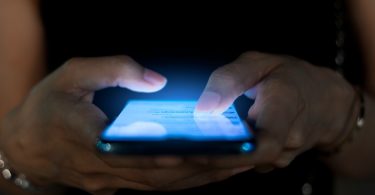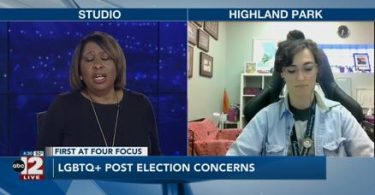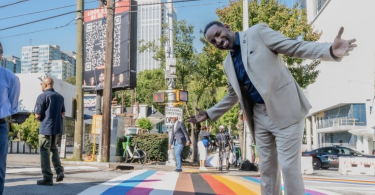I still remember the swell in my heart as I hung over the barrier watching my first Pride parade. I had known I was bisexual for many years at this point but on that day I was attending as a ‘straight tourist’.
I’d just made a bunch of new friends at college and convinced them to make the two-hour train trip to Sydney for the Mardi Gras parade.
I had told them about my ex-boyfriends from high school and my crushes on guys. But I had intentionally neglected to disclose my attraction to women. They assumed that I was as straight as they all were.
Hanging over that fence, having first real contact with the queer community, I desperately yearned to be a part of it. And yet I was very much on the outside. My bisexuality was completely invisible and I had no clear sense of how to gain access.
Moreover, I wasn’t entirely sure that I would have been included as an out bisexual anyway. Despite being the third letter in the LGBTI initialism, I don’t recall seeing a bisexual float or any real evidence of bisexuality in the parade.
More recently I’ve learned that bisexuals had previously been restricted from Mardi Gras membership and that those restrictions had only been removed in 2000. This was 10 years prior to my attendance.
At the time I simply knew that on some level this parade – the Sydney Gay and Lesbian Mardi Gras – wasn’t exactly for people like me.
I could feel his alcohol-laden breath on my face as he insisted I kiss his girlfriend
A few years later I attended again, this time in bi pride paraphernalia. I remember weaving my way through the crowd, trying to find my friends, when a drunk man with his arm draped around the woman beside him stopped me.
‘My girlfriend wants to make out with you,’ he said to me.
I mumbled that I wasn’t interested and went to move on. But his arm flew up in front of me. He trapped me between him and a wall. He leaned in close and I could feel his alcohol-laden breath on my face as he insisted I kiss his girlfriend.
The encounter intensified, as I repeatedly asked him to let me move on. And then it ended as quickly as it had begun. But I was left with the distinct impression that there were negative consequences for bisexual visibility as well.
Many of the events I attended were for ‘lesbians’ of ‘dykes’
Around the same time I moved to Sydney in search of the support of the queer community.
Many of the events I attended were described as ‘lesbian’ or ‘dyke’ events. Yet again, I was never entirely sure whether I was allowed to be there or not.
If the issue came up it seemed to be that bisexuals were allowed to be there, so long as we didn’t make too much of our bisexual identity or attraction to men.
So I didn’t.
For a while I listened silently as they boasted about their ‘gold star’ lesbian status. Indeed, they even lamented how gross they felt having sex with someone who had previously slept with men.
I nodded along as they traded stories about the bisexual women who had left them for men. They suggested that these women had never truly been interested in other women in the first place.
When other LGBTI people are biphobic, it has a bigger impact
The women I met during my brief foray into Sydney’s lesbian scene were not alone in their opinions of bisexuals. Almost 15% of Americans do not endorse bisexuality as a legitimate sexual orientation.
It’s true straight people tend to have a higher rate of negative attitudes towards bisexuals. However, when lesbian and gay people are biphobic, it can have a disproportionately negative impact on bisexuals. After all, like them, we seek out LGBTI communities for validation and support.
You can see this in the statistics too. For example, lesbians and bisexual women in non-urban areas have similar rates of frequent mental distress to each other. However, once they are in the cities, lesbians have much lower levels of mental distress. Bisexual women, on the other hand, see their rates double in urban areas.
Of course, gays and lesbians are better organised in urban areas. Therefore, it is likely that bisexual women in such environments feel even more isolated because they do not have access to a defined community.
Bisexuals have worse mental health even than gays and lesbians
In fact mental health research indicates that bisexuals are more prone to mental health issues than either heterosexuals or gay men and lesbians.
Bisexual men and women in Canada are six times more likely than heterosexual men and women to report seriously considering suicide at some point in their lives.
By comparison gay men and lesbians were four times more likely to say they had seriously considered suicide than heterosexual men and women.
Bisexual people also face very high rates of intimate partner violence, domestic violence, rape, and sexual assault. 61% of bisexual women and 37% of bisexual men have reported experiencing rape, physical violence, and/or stalking by an intimate partner at some point in their lifetime.
For comparison these acts of violence were reported by 44% of lesbians, 35% of heterosexual women, 26% of gay men and 29% of heterosexual men.
We need bisexual inclusion in Pride
In more recent years I’ve found a queer community which has plenty of space for bisexuals and pansexuals. And they include a whole host of other queers who are routinely invisible in mainstream LGBTI spaces.
I’ve become immersed in queer community where I feel truly supported and included. And I’ve marched a number of times in Mardi Gras with my bi pride sign waving high.
But in the many years I’ve been attending Mardi Gras since that first time in 2010, I’ve never once seen a bisexual float or a bisexual stall at Fair Day, the second biggest event in the Mardi Gras Festival calendar.
I’m aware that small bisexual organisations have marched occasionally over the years, but our presence is so small that it’s easy to miss.
Bisexuals have always been a part of Pride. Now it’s time to make sure Pride genuinely includes us.
Dylan Amy Stanford is doing a PhD on bisexual erasure in law and society at the University of Wollongong, Australia. You can follow them on Twitter.
Also on Gay Star News
Bisexual women are twice as likely to be abused by their partner
How my queer friends and I are celebrating Pride with selfies







